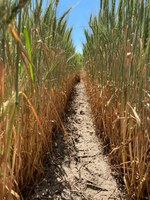Harvest Drought-stressed Small Grains as Forage
(Click the image below to view a high-resolution image that can be downloaded)
The unprecedented hot, dry weather in the upper Midwest continues to deteriorate large acreages of the small grains.
In some cases, grain yield potential has declined to a point where harvesting the small grains as forage may make more sense than waiting to harvest the crop as grain, according to North Dakota State University and University of Minnesota Extension specialists. Reports of producers chopping small grains for forage already have come in from dry areas of North Dakota.
“Before doing anything, begin having conversations with your crop insurance provider,” advises Jared Goplen, University of Minnesota Extension crop educator. “There are provisions related to harvesting drought-stressed crops as forages. To ensure crop insurance payments, you need to provide a notice of loss to your insurance provider and get those acres released. For additional information, contact your crop insurance agent.”
Additional information from the U.S. Department of Agriculture’s Risk Management Agency can be found at https://tinyurl.com/5aapxk5n.
Small Grains Make Excellent Forage
Small-grain hay and silage can make excellent forage. That is good news for producers because forage supplies will tighten if the drought conditions persist.
“The forage quality of small grains is largely determined by the growth stage when small grains are harvested,” says Jochum Wiersma, University of Minnesota Extension agronomist. “If your primary objective is tonnage, waiting to harvest small grains until the dough stage will maximize yield but will sacrifice forage quality.
“The heat and dry conditions have sped small grains along, meaning many are at or beyond the boot stage already,” he adds. “Quality will continue to go down as the small grains mature. If small grains are severely drought-stressed and withering away, additional biomass will not accumulate without additional moisture. Drought will likely not have a substantial impact on forage quality compared with conditions with adequate soil moisture.”
Forage samples should be collected from all harvested forage to test for forage quality. Some additional information regarding forage quality testing can be found at https://extension.umn.edu/forage-harvest-and-storage/measuring-forage-quality.
Check for Nitrates
The primary concern with harvesting drought-stressed small grains as forage is an excessive accumulation of nitrate. This can lead to nitrate poisoning without proper care.
“Prior to harvesting, small grains can be tested for nitrates with NDSU’s Nitrate QuikTest,” says Zach Carlson, NDSU Extension beef cattle specialist. “This screening tool assesses the nitrate level in standing forage. Extension agents who are certified can conduct the test in the field or, if necessary, at the office.
“Producers should provide a representative sample containing at least 20 stems by clipping the forage at ground level while traveling in a zigzag pattern across the field,” he adds. “The Nitrate QuikTest is not designed to analyze nitrate content in harvested forages.”
Following harvest, when submitting forage quality samples, be sure to have samples tested for nitrate content. Nitrate content does not decrease through time in harvested forages. Therefore, having a proper analysis to determine the nitrate content of small-grain forage before feeding it to livestock is important.
For help collecting forage samples, interpreting nitrate sample analysis results and additional information regarding nitrate poisoning in cattle, sheep and goats, visit https://www.ag.ndsu.edu/publications/livestock/nitrate-poisoning-of-livestock.
Harvesting
“As drought conditions intensify, the lower leaves on small grains will dry out, which increases leaf loss potential when harvesting as forage,” Goplen says. “Cutting and harvesting small grains prior to excessive leaf loss will improve yield and quality. However, small grains will likely have lower nitrate concentrations as the plants mature.”
Chopping small grains at 60% to 70% moisture is best to make good silage. In drought-stressed situations, the moisture content already may be below this level, meaning direct chopping likely will be best. If the moisture content is still 70% or greater, allow wilting time to decrease the moisture content.
The hollow stems in small grains cause some challenges in eliminating oxygen. Using a shorter cut length of 3/8 to 1/2 inch will assist with packing. Whether piling or bagging, insufficient packing will result in greater storage losses. Allow a fermentation period of at least 21 days before feeding.
“Another benefit of ensiling is it can reduce nitrates by 30% to 70%, meaning ensiling is the preferred harvest method for crops with concerns about high nitrate levels,” Goplen says.
Small grains can be made into dry hay, especially if nitrates are not a concern. More mature small grains can be deceivingly dry in some cases due to moisture present in developing heads, which can take more time to dry, compared with moisture in the stem.
Ensure baled small grains are dry enough, especially before storing inside buildings, to prevent hay fires. Using a conditioner can aid in dry down. If the crop is later in maturity, conditioners may increase shattering losses, however.
An alternative to making dry hay is making baleage, which works well for storing small grain forage. Regardless of the moisture content at which hay is harvested, ensure enough wrap is used (at least 6 mils), which typically means seven to eight wraps when accounting for the stretch of the plastic film.
For more information:
- Harvesting small grains for forage: https://extension.umn.edu/small-grains-harvest-and-storage/harvesting-small-grains-forage
- Managing feed high in nitrates: https://extensionpublications.unl.edu/assets/html/g1779/build/g1779.htm
- Testing silage and hay moisture at home: https://extension.sdstate.edu/silage-moisture-testing-tips
NDSU Agriculture Communication - June 24, 2021
Source: Zach Carlson, 701-231-7641, zachary.e.carlson@ndsu.edu
Editor: Ellen Crawford, 701-231-5391, ellen.crawford@ndsu.edu


